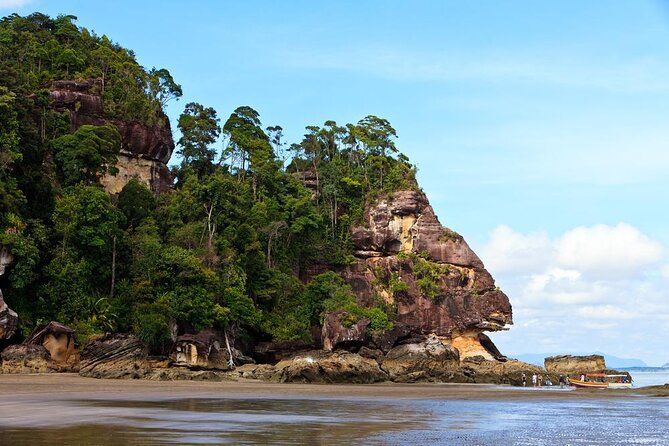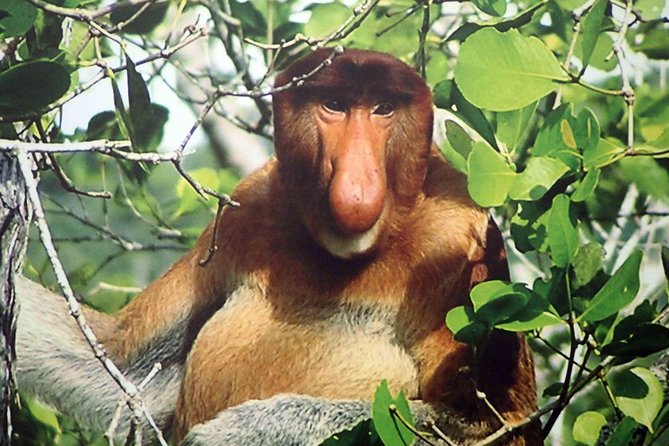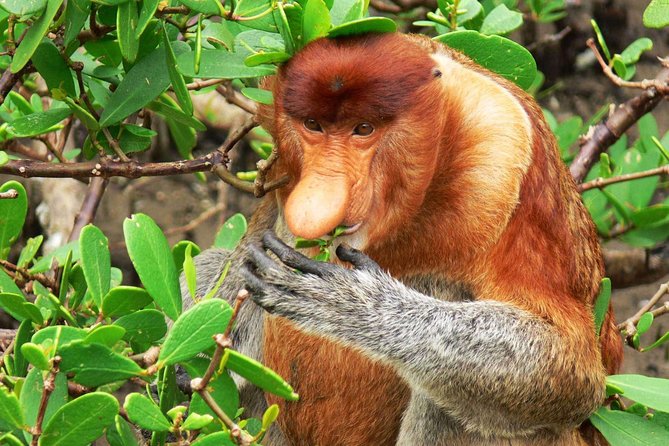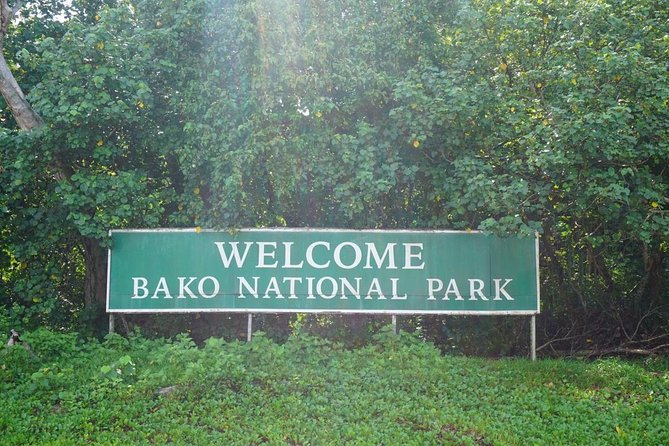Bako National Park, the oldest national park in the Malaysian state of Sarawak, offers visitors a unique opportunity to explore its diverse ecosystems and abundant wildlife. Spanning 16 square kilometers, the park boasts pristine beaches, lush mangrove forests, and rare species like the Proboscis and Silver Leaf monkeys. With highly knowledgeable tour guides leading the way, nature enthusiasts can enjoy the park’s remarkable biodiversity. But the real question is, what hidden gems await those who venture beyond the park’s well-trodden trails?
Key Points

- Bako National Park is the oldest gazetted national park in Sarawak, Malaysia, covering an area of 16 square kilometers.
- The park features seven distinct ecosystems, including pristine sandy beaches, lush mangrove forests, and towering mixed dipterocarp forests.
- Bako National Park is home to rare primate species, such as the Proboscis monkey and Silver Leaf monkey, as well as diverse flora and fauna.
- Visitors praise the park’s exceptional biodiversity, scenic coastal erosion, and the knowledgeable tour guides who enhance the overall experience.
- The park is accessible only via boat, and visitors should be prepared with appropriate gear, such as umbrellas, hats, and sturdy shoes.
Overview of the National Park

The serene expanse of Bako National Park, nestled within the lush landscapes of Kuching, Malaysia, stands as the oldest gazetted national park in Sarawak.
Spanning an area of 16 square kilometers, this haven boasts seven distinct ecosystems, from beach vegetation and cliff formations to mangrove forests and pristine sandy beaches.
Shaped by coastal erosion over time, the park’s unique geography features captivating sandstone structures, sea stacks, and towering cliff faces.
Visitors can enjoy the park’s diverse flora and fauna, including rare primate species like the Proboscis monkey, Macaque, and Silver Leaf monkey, as well as the elusive flying lemur and bearded pig.
You can also read our reviews of more tours and experiences in Kuching.
Diverse Ecosystems and Landscapes

Spanning an impressive 16 square kilometers, Bako National Park boasts seven distinct ecosystems that showcase the region’s remarkable natural diversity.
Visitors can explore:
- Pristine sandy beaches and dramatic cliff formations shaped by coastal erosion
- Lush mangrove forests teeming with unique flora and fauna
- Serene peat swamp forests, home to a variety of plant and animal species
- Towering mixed dipterocarp forests, characteristic of Borneo’s interior landscapes
- Unique heath forests adapted to nutrient-poor soils
- Verdant grasslands providing habitats for diverse wildlife
This extraordinary range of environments supports an abundance of flora and fauna, making Bako a true natural wonder.
Abundant Flora and Fauna
Bako National Park is home to an incredible abundance of flora and fauna, offering visitors unparalleled opportunities to witness the region’s diverse wildlife.
The park boasts the presence of three distinct monkey species – Proboscis, Macaque, and Silver Leaf – each with its unique behavioral traits. Visitors can also spot the elusive flying lemur, the rugged bearded pig, and the formidable monitor lizard.
The park’s diverse ecosystems, including peat swamp forests and mixed dipterocarp forests, provide a haven for a wide array of plant and animal life.
With knowledgeable tour guides leading the way, visitors are sure to leave Bako National Park with a newfound appreciation for the exceptional biodiversity of this protected area.
Visitor Experience and Recommendations
According to traveler reviews, Bako National Park is recommended by over 90% of visitors, with an overall rating of 4.5/5. The park offers an abundance of flora and fauna, including three monkey species, a flying lemur, bearded pig, monitor lizard, and viper.
Visitors praise the tour guides for their exceptional knowledge and organization.
-
The park features 11 reviews, with 8 five-star and 2 four-star ratings.
-
Highlights include the scenic coastal erosion, pristine sandy beaches, and diverse ecosystems.
-
Accessibility is limited, with the park not being wheelchair accessible but stroller accessible.
-
Visitors are advised to bring appropriate gear like umbrellas, hats, and sturdy shoes.
-
Surcharges of 30% apply during festive seasons.
Tour Details and Inclusions

The tour package to Bako National Park includes an eight-hour experience, covering entrance fees, guide and boat fees, transportation, and recommended gratuities.
The tour starts at 8:00 am, with pickup from hotels in Kuching city center. There’s a surcharge for pickup locations beyond 6 km.
Visitors should bring an umbrella or poncho, hat or cap, and wear good trekking shoes. Accessibility is limited, as the park isn’t wheelchair accessible, though it’s stroller accessible.
Surcharges of 30% apply during festive seasons. Lastly, the cancellation policy is non-refundable.
Accessibility and Requirements
One notable aspect of Bako National Park is its limited accessibility. The park isn’t wheelchair accessible, though strollers can be used. Visitors must come prepared with appropriate attire, including an umbrella or poncho, a hat or cap, and sturdy trekking shoes.
Additionally:
- The park is only accessible via boat, which may pose challenges for some travelers.
- During peak festive seasons, a 30% surcharge is applied to entry fees.
- The cancellation policy is strict, with no refunds offered.
- Facilities within the park are basic, with limited amenities available.
- Navigating the park’s trails requires a moderate level of physical fitness.
Seasonal Surcharges and Policies

Visitors to Bako National Park should be aware of seasonal surcharges that can significantly impact their costs.
During peak periods like Chinese New Year, Hari Raya, Gawai Dayak, Christmas, and the Rainforest World Music Festival, a 30% surcharge is applied. This means higher entrance fees, guide and boat fees, and transportation costs.
It’s important to factor these surcharges into the overall budget when planning a visit. Plus, the park’s cancellation policy is non-refundable, so travelers should carefully consider their travel dates.
Being mindful of these seasonal pricing fluctuations and policies can help ensure a smooth and cost-effective experience at this beautiful national park.
Traveler Feedback and Testimonials
Travelers have consistently praised Bako National Park for its exceptional beauty and diverse wildlife. Many have commended the park’s knowledgeable and well-organized tour guides, who’ve played a pivotal role in enhancing the visitor experience.
Some key highlights from traveler reviews include:
- Detailed insights and expertise shared by guides, allowing for deeper appreciation of the park’s ecosystems and wildlife
- Seamless coordination of transportation, entrance fees, and boat tours, creating a hassle-free experience
- Opportunities to spot a variety of fascinating species, including the iconic proboscis monkey, flying lemur, and bearded pig
- Stunning natural landscapes, from towering cliff faces to pristine sandy beaches
- Overall ratings consistently above 4.5 out of 5, reflecting the park’s enduring appeal among visitors.
Frequently Asked Questions
What Is the Best Time of Year to Visit Bako National Park?
The best time to visit is during the dry season from March to September, when the weather is generally sunny and pleasant. Avoid the rainy months of October to February for optimal hiking and wildlife viewing.
Are There Any Special Events or Activities at Bako National Park?
There are surcharges during festive seasons like Chinese New Year and music festivals, but the park offers abundant wildlife viewing opportunities year-round. Guided tours provide expertise in navigating the diverse ecosystems.
Can I Extend My Stay in the Park Beyond the Tour Duration?
Yes, visitors can extend their stay at the park beyond the tour duration. The park offers accommodations such as chalets and campsites, allowing travelers to enjoy the natural surroundings for a longer period.
Are There Any Restrictions on Bringing Food or Drinks Into the Park?
Visitors are generally allowed to bring their own food and non-alcoholic beverages into Bako National Park. However, it’s advisable to avoid leaving any litter or attracting wildlife by properly disposing of waste.
How Can I Prepare for the Weather Conditions at Bako National Park?
To prepare for the weather, visitors should pack an umbrella or poncho and wear a hat or cap. Comfortable, good trekking shoes are also recommended, as the park’s trails may be affected by rain or humidity.
Recap
Bako National Park offers an unparalleled opportunity to take in the wonders of Sarawak’s natural heritage. From the captivating coastal landscapes to the diverse array of flora and fauna, this exceptional destination promises an unforgettable experience for nature enthusiasts. With knowledgeable guides and seamless accessibility, Bako National Park truly lives up to its reputation as a must-visit attraction in Malaysia.
More Tour Reviews in Kuching
- Sarawak Cultural Village & Semenggoh Wildlife Center Tour
- Private Arrival & Departure Transfer : Kuching Airport (Sarawak)
- Private Transfer: Kuching International Airport to Hotel
- Private Arrival Transfer : Kuching International Airport (Sarawak) to Hotel
- Mountain Biking Gold Mine Full-Day Tour
- Kuching City Sightseeing Tour
Not for you? Here's more things to do in Kuching we have recnetly reviewed
- 4 Best Private Car With Driver Services In Kuching
- Fairy Caves and Wind Caves From Kuching City
- Semenggok Wildlife Centre
- Kuching Cultural & Heritage Tour With Sarawak Sunset River Cruise
- Kuching Heritage Tour With Sarawak Sunset River Cruise Review
- Sarawak Cultural Village Tour From Kuching
- Marvellous Creature Orangutan : Sarawak Semenggoh Wildlife Centre Tour
- Sarawak Bako National Park Tour : Pristine Rainforest Jungle
- 18 Best Tours In Kuching
- 6 Best National Park Tours In Kuching
- Kuching City Tour & Jongs Crocodile Farm Review
- Kuching Heritage City Tour Plus Sarawak Sunset River Cruise
